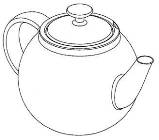People have been drinking tea for centuries, according to legend ever since leaves from a Camellia sinensis tree fell into some water being boiled for the Chinese Emperor Shen Nung nearly three thousand years ago, surprising him with a much more interesting drink than he thought he was getting.
 It was quite a bit later, in about 1662, that tea-drinking really got started in England when Charles II, who had enjoyed the odd cup whilst exiled in Holland, married Catherine da Braganza who came from Portugal where tea was a favourite beverage and who even brought with her a casket of tea as part of her dowry.
It was quite a bit later, in about 1662, that tea-drinking really got started in England when Charles II, who had enjoyed the odd cup whilst exiled in Holland, married Catherine da Braganza who came from Portugal where tea was a favourite beverage and who even brought with her a casket of tea as part of her dowry.
In 1840 Anna, wife of the seventh Duke of Bedford established the practice of afternoon tea to fill the gap between light luncheon and late dinner, a practice which soon became an English tradition, now celebrated all over the world.
Why then, after all this is it so difficult to find a decent teapot? I’m not looking for a Queen Anne or George IV teapot in sterling silver nor an antique Meissen or Coalport, not even one with the hand painted periwinkles like Mrs Bucket’s. All I want is an inexpensive, plain, everyday, white, 4/5-cup china teapot which doesn’t drip when you pour from it and the lid of which doesn’t fall off. I don’t want the latest thing in tea preparation with integrated see-through strainer, thermal-protective coating and ergonomically designed handle; unlike coffee, the domestic making of which has passed over the years through stir-and-settle; stir-and-strain; percolate; Cona; stir and filter; plunger pot; espresso – first stove-top then electric, and syphon, the making of a pot of tea has always been a simple matter, just one of infusing tealeaves in boiling water. It amazes me therefore that finding the basic equipment to do this is so hard. I like afternoon teas but having to wipe up drips and juggle the hot tumbling teapot lid at every pour would try the patience of the Duchess. So, sadly, for the time being my invitations to afternoon tea remain unsent, my recipes, unmade, unbaked and un-enjoyed but if you have more luck than me with teapots you might like to try these at your next tea party:
Maids of Honour (So named by King Henry VIII)
2 sheets sweet shortcrust pastry – thawed (can be made with puff pastry)
250g cottage cheese
80g caster sugar
50g currants
Grated zest of a lemon
20g ground almonds
2 eggs – beaten
3 tsp brandy
20g butter – melted
Pre-heat oven to 190˚C.
With a pastry cutter cut out 9 rounds from each sheet of pastry (best done while still partially frozen) and use them to line 18 greased patty pans. Keep in refrigerator.
Pass the cottage cheese through a fine sieve into a bowl. Add the remaining ingredients and mix well.
Half fill the tart cases with the cheese mixture and bake in the oven for 20 – 30 minutes until they are golden brown
A Trio of Club Sandwich Fillings
1. Chopped cooked chicken mixed with a little softened cream cheese (not the spreadable sort) and a pinch of Chinese 5-spice and on the next layer a spread of the same cream cheese and some toasted sliced almonds. Needs to be cut with very sharp knife.
2. Sliced Brie and on the next layer a thick paste made from sun-dried tomatoes, stoned black olives and basil.
3. Tinned tuna mixed with parsley, lemon zest and a little mayonnaise and on the next layer chopped spring onions and thin slices of crisp gherkins (I find Pam’s best)
How-Ever-You-Say-It Scones
225g self-raising flour
50g butter
40g caster sugar (use less if you prefer a not-so-sweet scone)
120ml milk
Beaten egg to glaze (if required)
Pre-heat oven to 200˚C
Sift flour into a bowl then rub in butter until it looks like breadcrumbs. Add sugar and mix well. Pour in milk and use a knife to mix into a soft spongy dough. Knead briefly on a floured surface then roll out to 2cm thickness. Cut out and either flour the tops for a soft crust or use egg to glaze. Bake at the top of the oven for 8-12 minutes. Serve warm.










Join the Discussion
Type out your comment here:
You must be logged in to post a comment.